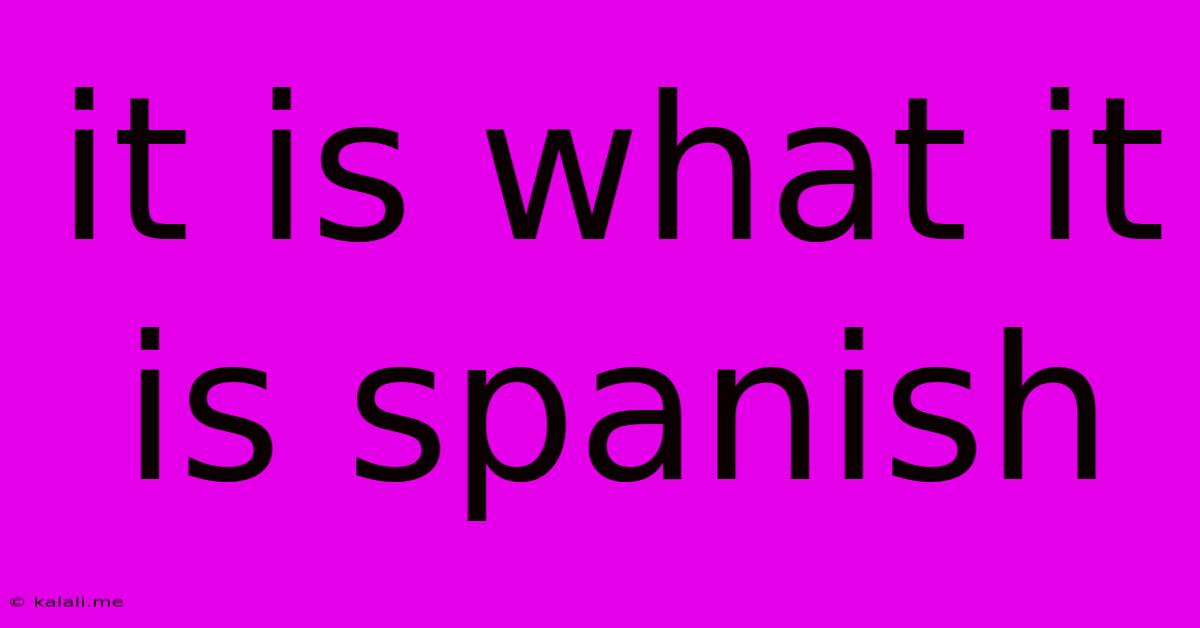It Is What It Is Spanish
Kalali
May 19, 2025 · 3 min read

Table of Contents
"Es lo que es" in Spanish: More Than Just a Phrase
"Es lo que es," a common Spanish phrase, translates literally to "it is what it is" in English. But its meaning transcends a simple statement of fact; it carries a nuanced blend of acceptance, resignation, and sometimes even a touch of defiance. This article delves into the deeper meaning of this phrase, explores its usage, and offers alternatives for expressing similar sentiments in Spanish.
Understanding the Nuances of "Es lo que es"
While a direct translation might suffice, understanding the cultural context is crucial. "Es lo que es" isn't simply a passive observation; it implies a level of acceptance, often in the face of something unavoidable or unchangeable. It suggests a conscious decision to let go of frustration or striving against the inevitable. Imagine facing a difficult situation – a missed opportunity, a broken relationship, or a personal setback. Using "es lo que es" acknowledges the reality of the situation without necessarily expressing defeat. It’s a way of finding peace amidst the storm.
Different Contexts, Similar Meanings
The phrase's usage varies depending on the context. It can convey:
-
Acceptance: This is the most common interpretation. It indicates a willingness to accept reality, even if it's not ideal. For example, if your plans are thwarted by unexpected rain, you might say, "Es lo que es; no podemos hacer nada." (It is what it is; we can do nothing.)
-
Resignation: In some situations, "es lo que es" might imply a degree of resignation. It's an acknowledgment that fighting the situation would be futile. For instance, if facing a bureaucratic hurdle, you might use the phrase to express weariness and acceptance of the delay.
-
A Touch of Defiance: Interestingly, "es lo que es" can also carry a subtle undertone of defiance. It can suggest a quiet strength, a refusal to be overwhelmed by the situation. It’s a way of saying, "This is how it is, and I will accept it, even if I don't like it."
Alternatives to "Es lo que es"
While "es lo que es" is perfectly acceptable and widely understood, several alternative phrases convey a similar sentiment:
-
Así es la vida: (That's life) This idiom is more general and reflects a broader acceptance of life's unpredictable nature.
-
Qué se le va a hacer: (What can you do?) This phrase emphasizes helplessness but also suggests a sense of resignation.
-
No hay nada que hacer: (There's nothing to do) This is a more direct expression of powerlessness.
-
Ya está: (It's done/It's finished) This focuses on the finality of the situation.
Using "Es lo que es" Effectively:
The key to using "es lo que es" effectively is understanding the context and your intended tone. It works best in informal settings and conversations where a degree of emotional understanding is already established. Overusing it can make you sound apathetic or dismissive, so choose your moments carefully.
Conclusion:
"Es lo que es" is more than just a simple translation of "it is what it is." It's a rich phrase that embodies a complex mix of acceptance, resignation, and even defiance. Understanding its nuances and exploring the various alternatives allows for more precise and impactful communication in Spanish. Knowing when and how to use this phrase can significantly enhance your Spanish fluency and cultural understanding.
Latest Posts
Latest Posts
-
How Often Should Spark Plugs Be Changed
May 19, 2025
-
How To Get Rid Of White Ants
May 19, 2025
-
Your Network Preferences Prevent Content From Loading Privately
May 19, 2025
-
I Hope You Don T Mind
May 19, 2025
-
Can You Put Spray Deodorant In Checked Luggage
May 19, 2025
Related Post
Thank you for visiting our website which covers about It Is What It Is Spanish . We hope the information provided has been useful to you. Feel free to contact us if you have any questions or need further assistance. See you next time and don't miss to bookmark.